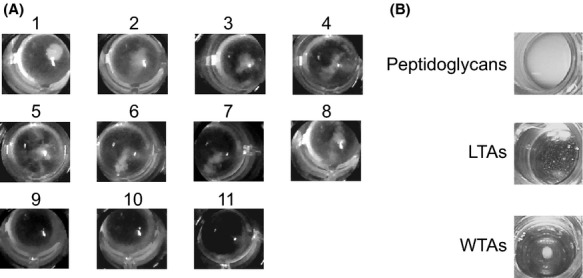Figure 5.

Investigation of the ORF16-binding molecule. (A) Aggregation assay against protein-and teichoic acid-depleted Staphylococcus aureus using rORF16-bound beads. The results of the aggregation assay with the following S. aureus samples are shown: untreated S. aureus cells in well 1, S. aureus autoclaved cells in well 2, S. aureus cells treated with SDS in well 3, S. aureus cells treated with trichloroacetic acid (TCA) in well 4, S. aureus cells treated with proteinase K in well 5, S. aureus cells treated with phenol–chloroform in well 6, S. aureus cells treated with n-butanol in well 7, S. aureus cells treated with Triton X-100 in well 8, S. aureus cells treated with NaOH in well 9, and S. aureus cells treated with HF in well 10. In well 11, the rORF16-bound beads were mixed with PBS only. Wells 1–8 contains aggregates, whereas wells 9–11 do not contain aggregates. (B) Aggregation assay against cell wall molecules using rORF16-bound beads. The rORF16-bound beads were mixed with S. aureus peptidoglycans, LTAs, and WTAs. An aggregate was observed in the mixture with WTAs, whereas aggregates were not observed in the mixtures with peptidoglycans and LTAs.
